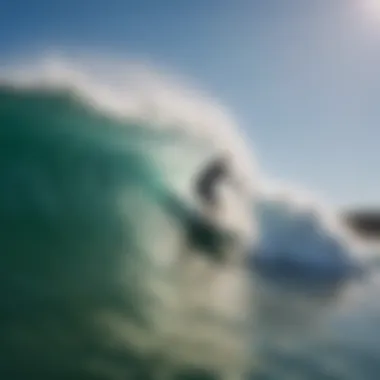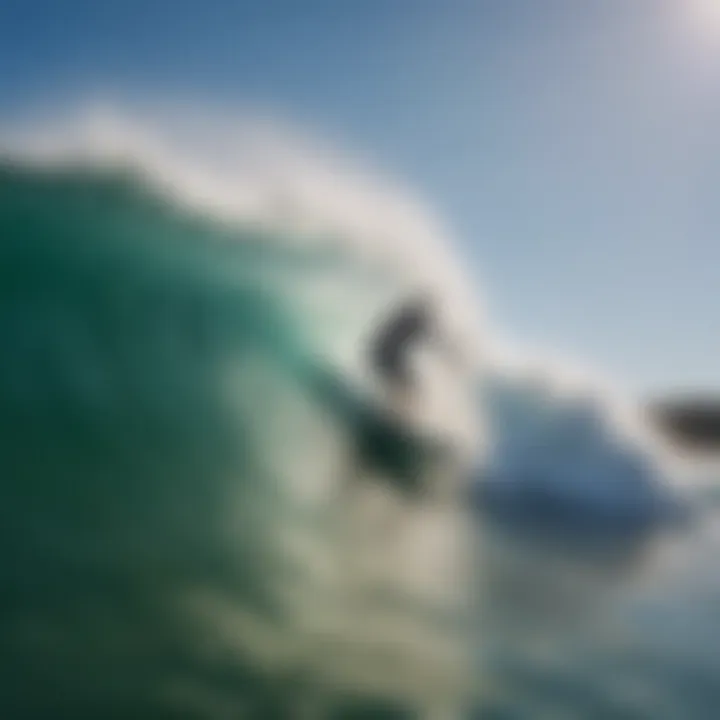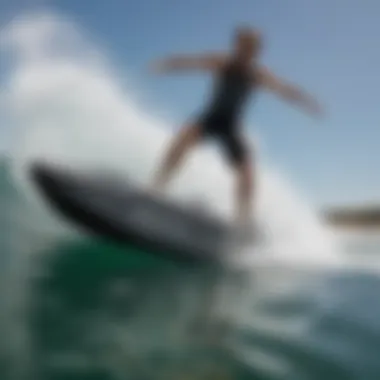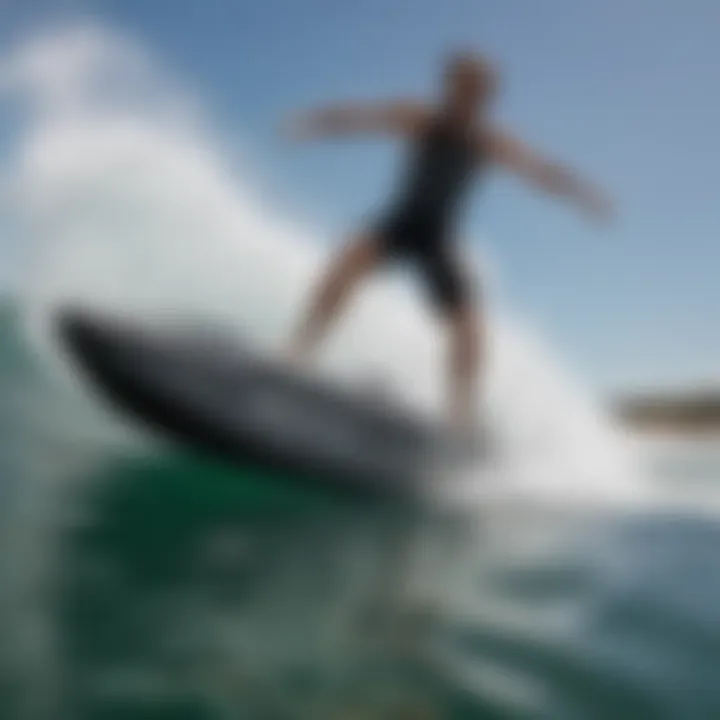Lead Weights for Wakesurfing: The Ultimate Guide


Intro
When one sets out to conquer the waves with a wakesurf board, success often hinges on factors that extend beyond the rider's skill alone. Among the myriad of elements influencing the surfing experience, lead weights emerge as pivotal components. They act like the secret sauce that can turn a mediocre wave into one that feels just right. Understanding how to use these weights effectively can enhance wave formation and rider performance, making every outing on the water a delight.
Like many water sports, wakesurfing thrives on balance—both in technique and in the equipment used. With lead weights, the challenge is not just about adding weight but also achieving that sweet spot. Too little might lead to subpar waves, while too much can tip the boat's stability the wrong way. The key is knowing the right adjustments based on the boarders, boat, and intended riding style.
There’s more to lead weights than simply dropping them into the water. Their placement and the materials used can have significant effects on wave dynamics. Think of it as composing a symphony; you want all instruments to harmonize for the best performance. This guide delves into various aspects of using lead weights in wakesurfing, offering insights from basic techniques to the advanced applications that seasoned athletes might explore.
As we navigate through this topic, you’ll gain a clearer understanding of how these weights can help craft your perfect wave. We'll also cover safety practices, material choices, and environmental considerations, as these factors can’t be overlooked in today’s eco-conscious world.
So, whether you’re just dipping your toes into wakesurfing or you’re an old hand steering your crew to the best breaks, this guide is bound to add a little more depth to your watersport journey.
Understanding Wakesurfing
Wakesurfing is more than just riding the waves; it’s an exhilarating experience that brings riders closer to the water while maintaining a safe distance from the boat. Understanding the nuances of wakesurfing is crucial, especially for those diving headfirst into this thrilling sport. This section aims to highlight the essential elements of wakesurfing, outlining its fundamental principles and the pivotal role wave formation plays in the overall experience.
Definition and Fundamentals
Wakesurfing involves riding a surfboard on the surface of a boat's wake, without being attached to the vessel. The basic concept is rooted in generating waves that are both rideable and safe, creating a unique environment that combines the excitement of surfing with the control of boating. In wakesurfing, the boat typically travels at slower speeds — between 10 to 12 miles per hour — allowing the rider to skillfully navigate the stationary wave.
Aside from the thrill, the sport caters to various skill levels. Beginners can enjoy learning balance and control, while even seasoned surfers find joy in mastering new tricks. In essence, wakesurfing offers something for everyone, making it an ideal choice for water sports enthusiasts looking to deepen their adventure.
The Importance of Wave Formation
Wave formation is the beating heart of wakesurfing. The way a wave is shaped directly impacts the ride a wakesurfer experiences. The size and consistency of the wave depend largely on the boat’s speed, weight distribution, and hull design. For instance, boats with a deeper V-hull tend to generate larger, more sculpted wakes that are perfect for carving and tricks. Understanding the dynamics behind wave formation can enhance your wakesurfing experience significantly.
- Key Factors Influencing Wave Formation:
- Boat Type: Different boats yield different wave types. A ski boat produces a different wake compared to a surf boat.
- Weight Distribution: The strategic placement of lead weights can greatly impact the height and shape of the waves.
- Speed: Maintaining an optimal speed is crucial for achieving the desired wave effect.
Proper wave formation not only boosts the thrill of the ride but heavily influences rider safety and enjoyment. Consequently, knowing how to generate and ride waves can lead to a more rewarding wakesurfing session. As surfers like to say, "it's all about riding the right wave."
"The wave you ride can shape your experience; mastering it brings you closer to the essence of wakesurfing."
Role of Lead Weights in Wakesurfing
In the art of wakesurfing, the role of lead weights cannot be overstated. These weights serve as a pivotal component, finely tuning both the watercraft and the experience on the liquid playground. By strategically positioning lead weights, wakesurfers have the power to influence various factors, most notably wave quality and stability. Understanding how and why this works is crucial for anyone preparing to hit the water.
Weight Distribution and Wave Height
When it comes to generating the perfect wave, weight distribution plays an invaluable role. When lead weights are added to the boat, they contribute to shifting the center of gravity. This shift, in turn, affects how the boat interacts with the water. A boat that’s overweighted at the back, for instance, will create a larger wave at the wake's rear, leading to a more enjoyable ride for the surfers.
On the other side of the coin, placing too much weight in one spot or unevenly can lead to undesirable results. The boat might sit too low in the water, causing not just a decrease in wave size but also making it more difficult for riders to maintain their balance.
To achieve that enthralling wave height, a few techniques can be employed:
- Centre the weight: Keeping lead weights evenly distributed can enhance wave quality, allowing for a cleaner surfable wave.
- Rear weight: Shifting weights towards the back of the boat increases wave size, a method often favored by more experienced surfers.
This delicate balance in weight distribution is key to maximizing wave potential.
Stabilization and Control
Another significant benefit of using lead weights in wakesurfing is the increase in stabilization and control it provides. As anyone who's ridden a boat knows, unpredictable shifts in weight can lead to a bumpy ride, and nobody enjoys being tossed about like a rag doll. By utilizing lead weights effectively, wakesurfers can achieve a smoother glide across the water and maintain control even in less-than-ideal conditions.
Weight allows for the smooth navigation of choppy waters, minimizing the unwanted bounce that accompanies sudden wakes caused by other boats or natural elements. Riders, particularly beginners, find that increased weight on the boat ensures a steadier interaction with the wave, allowing for a more enjoyable experience.
Here are some considerations for stabilizing effects:


- Weight placement: Positioning lead weights low in the boat can help lower its center of gravity, improving stability significantly.
- Types of conditions: Different water conditions may require adjustments in weight to manage turbulence effectively. Experimentation with placement can yield beneficial results.
Ultimately, appreciating how lead weights function in wakesurfing is essential for enhancing both performance and enjoyment on the water. The strategic application of weight can elevate a typical session out on the lake into a truly memorable ride.
"In wakesurfing, it’s not just about catching the wave; it’s about catching the right wave. Lead weights are the unsung heroes of that pursuit."
The nuances behind lead weights open up a world of adventures for water sports enthusiasts. Understanding their function underscores the essence of thoughtful application and placement, enabling wakesurfers to harness the waves with greater mastery.
Types of Lead Weights
When it comes to wakesurfing, understanding the types of lead weights available is crucial for maximizing your wave experience. These weights play a significant role in shaping the water dynamics around your boat. Their application can alter not only the wave height but also the quality of the ride. This section will delve into the standards and customizable options of lead weights, each having its distinct advantages and considerations.
Standard Lead Weights
Standard lead weights are the bread and butter of wakesurfing. Usually made from solid lead, these weights come in varying sizes and shapes, typically designed to be easily placed or mounted onto your boat. Their primary job is to lower the boat's profile in the water, enhancing wave creation.
- Easy Accessibility: Most boats come equipped with the capacity to attach standard lead weights. Whether you drop them in a designated compartment or fix them to the rails, the setup is relatively hassle-free.
- Cost-Effectiveness: Generally speaking, standard lead weights are more budget-friendly compared to custom solutions. If you're just getting into wakesurfing, using these weights offers a practical way to explore different setups without breaking the bank.
- Predictable Performance: Since they are widely used, there's lots of shared knowledge and experience related to standard lead weights. Forums and communities can provide insights about their effectiveness in various conditions.
However, using standard lead weights has some drawbacks. The biggest one is lack of flexibility. You might find that while they create a decent wave, they don’t provide the fine-tuning that more experienced riders may need to perfect their craft.
"It’s like using a hammer to drive a nail; it gets the job done, but sometimes that fine-tipped screwdriver is what you really need."
Customizable Options
Customizable lead weights have gained traction among serious wakesurfers. The essence of these weights is their flexibility to be adjusted according to individual needs and specific riding styles. Here’s a deep dive into the advantages:
- Tailored Weight Levels: With customizable options, you can tweak how much weight you are adding to the boat. This is especially beneficial when you're dealing with different water conditions or boat types. More weight might be needed in choppy waters compared to still ones.
- Shape Variability: Custom weights can be designed to suit particular locations on your boat. For example, a weight that contours to the shape of your boat’s hull could potentially enhance the water displacement.
- Advanced Materials: Beyond lead, some companies are exploring alternative materials like tungsten, which offer a similar weight in a smaller volume. This allows for less bulky weight placement that keeps the boat’s aesthetics intact.
However, such options can be more costly. It is essential to weigh your requirements before diving into deep customization.
As you can see, understanding the variety of lead weights available will help you make an informed choice tailored for your wakesurfing needs. Whether you go for standard options or delve into bespoke designs, each has its place in crafting the perfect wave.
Choosing the Right Weight
Selecting the right weight for wakesurfing involves much more than just tossing some lead overboard. It’s about understanding how the dynamics of your boat and the water play a crucial role in shaping your surfing experience. The right lead weight can mean the difference between a sluggish wake and one that propels you into exhilarating maneuvers.
With various factors to take into account, from the dimensions of your boat to the skill level of the rider and the current water conditions, making an informed choice is paramount.
Factors to Consider
Boat size and type
The boat size and type heavily influence the effectiveness of lead weights. It's pretty simple: larger boats can handle more weight and still maintain stability, while smaller boats might struggle under the same conditions.
For instance, a 23-foot wake boat can typically accommodate more lead than a 20-foot ski boat without losing its balance. The key characteristic of larger boats is their capacity to create a substantial wake, driven by a powerful engine and a hull designed for such activities. This makes them a popular choice among wakesurfing enthusiasts.
However, while larger boats provide a massive wave, they may require more attention to prevent overloading, which can adversely affect performance. Smaller vessels, on the other hand, are easily maneuverable but may struggle to deliver the same quality of wave height without adequate weight. As such, it’s essential to match the weight to the boat type you are using for an optimal experience.
Rider skill level
Rider skill level is another fundamental aspect that determines the amount of lead weight you should use. Beginners often need a different setup than seasoned surfers. For novice riders, a weight setup that provides a stable wake helps them learn without the risk of falling off constantly.
Conversely, more experienced wakesurfers might prefer a more nuanced approach to weight distribution, opting to use less weight to achieve a more dynamic wave. This allows them to work on tricks and maneuvers. The unique feature here is the ability to adjust weights according to the rider’s progression. Alternatively, using too heavy a load for beginners can lead to frustration and an uncomfortable experience in the water.
Water conditions
Evaluating water conditions is crucial when selecting lead weights for wakesurfing. Different conditions—whether calm, choppy, or with waves—require varying approaches to weighting the boat. Tranquil waters often demand less weight, as the wave shape holds better without resistance. On the flip side, rough or choppy conditions could necessitate additional weight to stabilize the boat and generate a cleaner wake.
Understanding this aspect is beneficial because the unique characteristics of the water can enhance or diminish the wakeboarding experience. For instance, during a calm day on a lake, riders might find that too much weight leads to an awkward ride. In contrast, heavy waves from wind make the scenario different and sometimes demand more stability. Hence, keen awareness of current water conditions is critical for an enjoyable outing.


Testing and Adjustments
Testing different lead weight configurations can't be underrated. Riders should start with baseline weights and adjust gradually while observing the changes in their wake's form and size. Keeping a log of experiments can help identify the sweet spot for both novice and experienced surfers alike. Knox yawning after they took a spill, noting down their learning paths can provide great insight into what works the best.
Be prepared to make adjustments on the fly: if the wake feels off, or if the boat is handling poorly, reevaluating the weight distribution immediately is key. Every ride is a chance to learn and refine the setup further.
Weight Placement Techniques
When it comes to wakesurfing, the importance of weight placement can’t be overstated. The right positioning of lead weights fundamentally shapes the wave you ride, enhancing your overall experience in the water. Properly placed weights lead to a balanced boat and a well-formed wave, while missteps can lead to a chaotic ride, making waves unpredictable and difficult to surf. These techniques ensure that you not only ride smoothly but also have a safer and more enjoyable experience.
Optimal Locations on the Boat
Selecting the right spots to position the lead weights is crucial for maximizing wave performance. You can think of the boat’s layout as a puzzle; each piece must fit for optimal results.
- Back of the Boat: The most common choice! Placing weights at the rear generates a larger, more powerful wave. It’s a go-to spot for many surfers. However, adding too much weight here can make steering trickier.
- Side Placement: Adjustments on the sides can significantly enhance wake shape. This technique can produce those dreamy, long rides that wakesurfers crave. Balancing the weights on both sides ensures that your boat doesn't lean, helping maintain control throughout your session.
- Underneath Seats or Compartments: Some boats come equipped with spaces specifically for weight – utilizing these can keep things tidy and out of the way. While they may not significantly change the wake, they help retain a clean look on your boat.
Using proper techniques for weight placement can mean the difference between a trip that’s just a ride and one that’s a memorable adventure on the water.
Balancing the Load
Achieving balance isn’t just about where you place the weights; it's also about how they affect the boat’s entire setup. An imbalanced load can lead to complications both for the driver and the rider. Think of it this way: like a cake, every ingredient has to be right for the final product to be pleasing. Here are some key points to consider:
- Assess Weight Distribution: Look at how the weight affects the boat and the wave. If you’re feeling the boat list, adjust the weight until it sits evenly.
- Trial and Error: Don't shy away from experimenting. Each boat behaves a bit differently. A good starting point is to add weights incrementally and see how the wave changes.
- Rider Position: The skill and weight of the rider can also impact balance. Novice surfers may not weigh much but might benefit from extra weight to shape the wave effectively.
"Finding the right balance requires a keen eye and a willingness to tweak as you go. It’s all about adapting to the conditions and what feels right in the moment."
- Documentation: Remember to keep notes of your weight placements and adjustments. Over time, this data becomes invaluable in guiding your decisions for different conditions.
Safety Considerations
Wakesurfing is an exhilarating sport that beckons many to the water, but with that thrill comes a host of responsibilities. Understanding safety considerations is paramount, especially when using lead weights. These weights can significantly affect the dynamics of your boat and its passengers. The proper approach to safety ensures not just the well-being of the surfer, but also everyone on board. The implications of mismanaged weights range from minor inconveniences to potentially life-threatening situations.
Proper Handling of Lead Weights
When it comes to handling lead weights, a few key practices can make all the difference. First, it's crucial to always use the right gear. Check the weight capacity of your boat before adding any lead weights. Overloading can lead to instability, making navigation difficult, particularly in choppy waters.
Additionally, wear gloves when handling lead weights. While it may seem excessive, lead is a toxic material. You want to avoid skin contact, especially if handling larger weights. Secure the weights firmly to prevent them from slipping or rolling during movement. They can be dangerous projectiles if they’re not anchored properly.
Here are some important guidelines for safe handling:
- Wear protective gloves while handling weights.
- Ensure proper weight distribution to maintain balance on the boat.
- Avoid contact with water; if weights get wet, dry them before storing.
- Store correctly after use, keeping them in a safe, dedicated spot.
"A simple oversight in managing loads can transform a good day into a disaster. Safety first!"
Environmental Impacts
Using lead weights in wakesurfing isn't just about safety on the water; it also raises some serious environmental considerations. Lead is a heavy metal that can leach into the aquatic ecosystem, posing risks to marine life and water quality. Responsible practices can help alleviate these negative impacts and preserve our valuable waterways.
Consider these points when weighing the environmental footprint of lead weights:
- Runoff and Contamination: When lead weights come into contact with water, they can corrode and release harmful substances. Avoid dropping weights overboard, and clean them regularly to prevent corrosion.
- Alternative Materials: Investigate non-lead options that may have lesser impacts on the environment, such as steel or other eco-friendly materials. These alternatives not only help preserve the marine ecosystem but can offer the same benefits of weight distribution.
- Responsible Disposal: If you must replace lead weights, don’t just toss them. Many local waste facilities can properly dispose of hazardous materials. Look for recycling programs that accept lead weights.
By understanding how to properly handle lead weights and the associated environmental impacts, enthusiasts can enjoy wakesurfing while being responsible stewards of the waters they cherish.
Alternative Weighting Options
When discussing the world of wakesurfing, the concept of lead weights often takes center stage, but it’s crucial to consider what alternative options are available. Utilizing alternate weighting methods can enhance your wakesurfing experience by offering numerous benefits and considerations that might not be immediately apparent.


Non-Lead Materials
In recent years, concerns regarding the environmental impact of lead have prompted many wakeboarders to explore non-lead materials. These alternatives can include a variety of compounds such as steel, concrete, and plastic. Each of these materials provides distinct advantages that can positively impact your wakesurfing journey.
- Safety: Firstly, using non-lead materials can significantly reduce the risk of environmental contamination. If a weight happens to fall overboard, non-lead options minimize potential harm to marine life and ecosystems.
- Durability: Plastic-based weights, for example, are often resistant to corrosion and therefore have a longer lifespan. Corrosion can easily compromise lead weights, making them less effective over time.
- Customization: Non-lead materials can often be molded into different shapes or sizes, allowing riders more flexibility in how they set up their weight systems. Heavy-duty plastic weights can come in a variety of eye-catching colors too, giving that visual flair.
However, it's also important to keep in mind that certain non-lead options might not provide the same weight-to-volume ratio as lead. So, while they can be environmentally friendly, you’ll need to experiment with various sizes and amounts to find what truly works best for your setup.
Using Water Ballasts
Water ballasts are another excellent alternative to traditional lead weights. Essentially, these systems use water to adjust the boat's weight, enhancing the wave's size and shape without the downsides of heavy materials. Here’s how they work and their benefits:
- Flexibility: Water ballasts allow for easy adjustment. By simply adding or removing water, you can modify the weight distribution on-the-fly. This fluidity means you can adapt to differing water conditions or rider preferences quickly.
- Efficiency: Using water can be more efficient than lugging around heavy lead. Your boat will use less fuel, as it won't have to push as much weight through the water if the ballast is not filled to the max.
- Control Over Wave Dynamics: Water presents unique patterns that can mold your wave to your liking. By manipulating the water ballast, you can create a customized ride that's ideal for various skill levels — whether you want mild waves for beginners or larger ones for advanced tricks.
Nonetheless, it is advisable to ensure proper sealing of the ballast tanks to prevent any leaks, which can affect both performance and safety. Before venturing out onto the water, always inspect your setup.
"Proper choice of weights is key in creating an optimal surfing experience. Water ballasts and non-lead alternatives not only prove functional but also ecologically sound."
Exploring alternative weighting options opens up a world of possibilities for wakesurf enthusiasts. Whether you’re concerned about environmental impact or looking for adaptable systems, there's potential in non-lead options that can significantly enhance your experience on the waves.
Maintenance of Lead Weights
Taking care of lead weights used in wakesurfing is an aspect that many might overlook but shouldn't. Neglecting maintenance can lead to decreased performance—affecting not just waves but safety, too. Proper maintenance ensures that weights perform optimally while also extending their lifespan, saving hassle in the long run.
Cleaning and Care
Regular cleaning of lead weights is essential to remove dirt, grime, and any water residue that can accumulate over time. That buildup can hinder effectiveness and may even affect how the weights interact with the water. Here are some practical tips for cleaning:
- Rinse After Use: After every session, a quick rinse in fresh water helps prevent corrosion. If your weights tend to be really disgusting, use a soft brush.
- Inspect Regularly: Keep an eye out for any signs of wear, cracks, or rust. Catching these issues early can prevent bigger problems down the line. If you spot issues, it's best to take action sooner rather than later.
- Storage: Store weights in a cool, dry area away from direct sunlight. UV rays can cause degradation, and moisture can lead to corrosion.
For stubborn stains, try using a mixture of vinegar and water as it can be quite effective without damaging the weights. Avoid harsh chemicals that could degrade the lead over time.
Longevity and Replacement
Knowing when to replace your lead weights is crucial. Even with stellar care, lead can wear out. Here's how you can gauge when it’s time for a switch:
- Signs of Damage: If you notice visible disintegration, such as cracks or significant rusting, it’s high time to consider a replacement.
- Weight Performance: If there’s a noticeable difference in wave quality or boat stabilization when wakesurfing, that might be a telltale sign that your weights aren’t performing the way they used to.
- Frequency of Use: If you’re hitting the surf regularly, weights will naturally degrade faster. Those who frequent the water need a more vigilant maintenance routine.
"Taking care of your lead weights isn’t just a chore; it’s a step toward enhancing your overall wakesurfing experience. The more you care, the better your performance on the water will be."
Replacing worn weights should be seen as an investment rather than an inconvenience. Newer weights often come with enhanced features, such as better hydrodynamics or adjustable designs. Whether sticking to classic lead or exploring alternatives, fresh weights can bring an unanticipated upgrade to your wakesurfing adventure.
In summary, maintaining lead weights is not merely about keeping them clean; it’s about ensuring a safe, enjoyable experience out on the water. Regular upkeep and timely replacements will not only save you time but also amplify your wakesurfing performance, letting you focus on the fun side of things.
Closure
Wrapping things up, the discourse surrounding lead weights in wakesurfing highlights how essential it is to get this right for both performance and safety. The proper utilization and maintenance of these weights significantly influence wave creation, rider balance, and overall experience on the water. Not to mention, understanding the implications of weight adjustments can lead to more thrilling sessions while reducing any potential risks associated with improper handling.
Summarizing Key Insights
When it comes to lead weights, a few key takeaways stand out:
- Weight Adjustments Matter: The way weight is distributed on your boat can make or break your waves. A poorly balanced boat leads to disappointing surf conditions.
- Safety First: Proper handling of lead weights ensures an enjoyable and secure wakesurfing experience. The avoidance of hazards caused by incorrect placement or negligence is undeniably important.
- Environmental Awareness: Opting for eco-friendly materials or methods, such as water ballasts, resonates well with today’s environmental consciousness.
These insights remind us that attention to detail isn’t just a feather in your cap; it’s vital for mastering the nuances of wakesurfing. Each ride can be enriched when we understand the profound influence of lead weights on water dynamics.
Final Thoughts on Wakesurfing Weights
In the end, experiencing the waves to their fullest is what every wakesurfer craves. Lead weights may seem like a small aspect of the sport, but their role doesn’t go unnoticed. Just like the tide, knowing when and how to adjust can elevate your sessions. Whether you are a novice grappling with the basics or a seasoned pro looking for that elusive perfect wave, having the right knowledge about lead weights gives you an edge.
As you venture out on the water, remember that the precision of weight placement leads to fantastic surf conditions, improved stabilization, and an overall more enjoyable ride. Equipping yourself with this knowledge nurtures not just a better experience for you but also contributes to a more sustainable future, allowing all of us to enjoy the beauty of wakesurfing for years to come.
"Success in wakesurfing starts with the right gear, but mastering its use is where true skill shines."
For additional resources and community discussions, consider checking Wikipedia, Britannica, or engaging with other enthusiasts on Reddit. There’s always something new to learn in this thrilling water sport.















